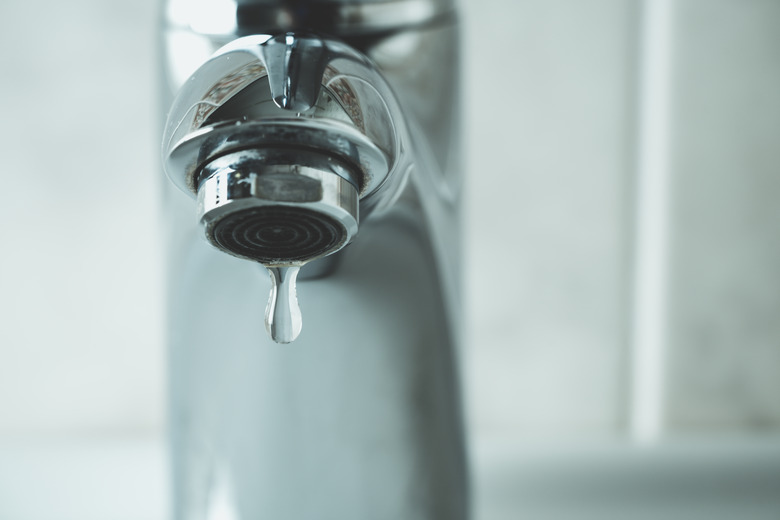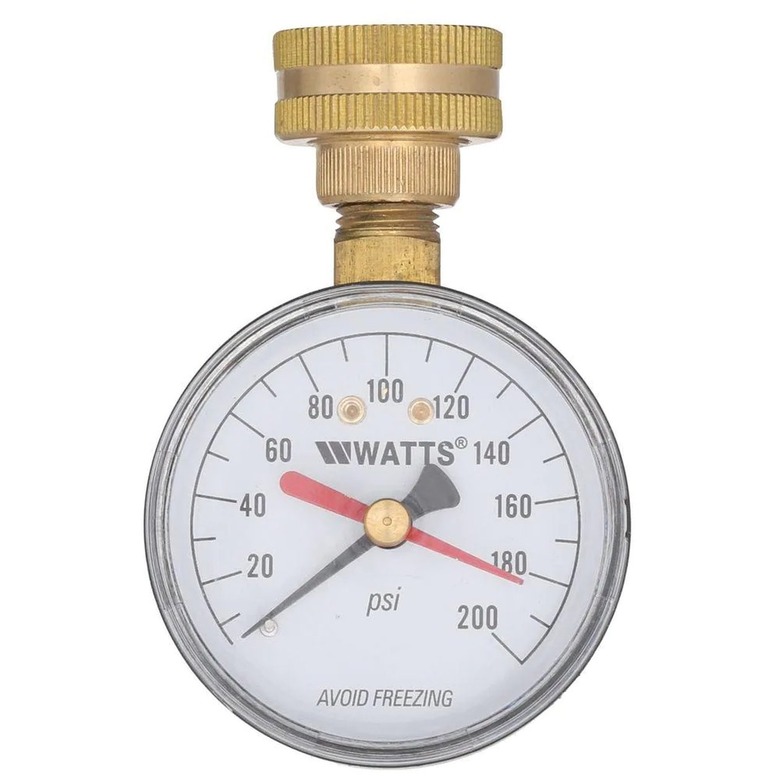It's Easier Than You Think To Check Your Home's Water Pressure: Here's How To Do It
We may receive a commission on purchases made from links.
If you've ever had difficulty spraying off dishes or felt discomfort from the water in the shower, it might be worth checking to see if your home's water pressure is too high or too low. A simple way to do this is by using a water pressure gauge, which helps you easily measure the water pressure to determine if it's in the normal range. Regular pressure checks help you make little changes when necessary to keep your plumbing system at the right water pressure.
Though it might seem small on the scale of things to worry about in your home, without the right amount of water pressure, your faucets and water-based appliances won't work properly or might even wear out quicker.
Normal Water Pressure Range
Normal Water Pressure Range
Your home's water pressure is described as pounds per square inch, or psi, and using a gauge to check your water pressure helps you determine if it's in the ideal range, which is between 45 and 80 psi for residential applications. When your water pressure is below 40 psi, it's considered low, and anything below 30 psi is considered too low for homes. Building codes usually establish the minimum water pressure, with most requiring at least 20 psi. If your water pressure is above 80 psi, it's too high for home plumbing.
Problems With High Water Pressure
Problems With High Water Pressure
When your water pressure goes beyond 80 psi, it's hard on all of your plumbing, including the pipes, joints, and fixtures. It can cause pipes to rupture and can damage joints and other plumbing components, which can cause leaks. If the leaks are minor, you might not notice them right away, but if the water continues dripping it could cause damage to a wall or surround — or cause mold growth.
Other problems that can come with high water pressure include:
- Water hammer: Too much pressure can cause the pipes to bang into each other or other structures, producing a loud sound called water hammer. In addition to the loud, annoying sound, this condition can loosen or damage your plumbing.
- Increased water usage: With high water pressure, more water comes out of the faucets every time you use them. This can result in wasted water, which can increase your water bill and isn't good for the environment.
- Appliance wear and tear: Excessive water pressure going into your washing machine, water heater, or dishwasher can make parts wear out sooner. Some appliance warranties won't cover damage from water pressure issues.
- Dripping fixtures: The excess pressure can cause your faucets and showerheads to drip.
Problems With Low Water Pressure
Problems With Low Water Pressure
You might experience a sudden water pressure drop that's temporary, or you may have consistently low pressure. Either way, it can make life difficult when you try to take a comfortable shower, wash dishes, or water your garden with a hose. You get poor performance from all water fixtures, and your water-using appliances might not work well. You might not get enough pressure from your shower fixture to rinse your hair thoroughly. It can take much longer to fill a tub or sink with water because of the slower water flow.
How to Use a Water Pressure Gauge
How to Use a Water Pressure Gauge
A simple hose bibb-style water pressure gauge is an inexpensive tool that lets you quickly measure your home's water pressure. It simply screws onto the faucet where you want to check the pressure. The dial is easy to read, so you can quickly verify the psi reading. Check your water pressure a few times each year if you notice a change in water pressure, or if you suspect an issue with it.
The most common place to attach a water pressure gauge is on your outdoor hose faucet due to its location near the main water supply. It most likely has the largest water supply pipe leading to it, unlike other plumbing fixtures in your home, which often have a reduced supply line size.
Tip
If you don't have an outdoor faucet, you can use the gauge on your washing machine's cold water supply. If you have well water, choose the plumbing fixture that's closest to the pressure tank for your well.
1. Shut off everything that uses water
To start, ensure everything that uses water in your home is shut off, including appliances, faucets, and sprinkler systems. The results aren't accurate if any water fixtures are running at the time.
2. Remove your garden hose
Remove your garden hose from the faucet if you have one attached. Hand-tighten the gauge onto the faucet, ensuring it has a good seal and doesn't leak. These gauges typically have a rubber gasket to get a good seal, but they can sometimes leak if they're not tight enough. Tighten it with a wrench if needed to stop it from leaking.
3. Turn on the faucet
Turn on the outdoor faucet completely. The dial will show you the water pressure in psi. Look for a measurement between 45 and 80 for optimal home use. If it measures near or over 80 psi, take steps to decrease the pressure immediately to prevent damaging strain on the plumbing. If it's lower than 45 psi, increasing the water pressure can make your fixtures work better.
Correcting High Water Pressure
Correcting High Water Pressure
Lowering high water pressure is essential to protect your plumbing system. One place to start is to have a plumber install a water pressure regulator if you don't already have one. This is a bell-shaped valve near the water supply line running into your home that slows down the water pressure from the municipal source, which is often too high for your home pipes.
If you already have one, adjusting the water pressure regulator can help reduce the pressure. Use an adjustable wrench to loosen the locknut on the regulator. Then, turn the adjustment screw counterclockwise to lower the water pressure coming into your home. Adjust it in small increments, testing the pressure after each adjustment so you don't go too low.
Correcting Low Water Pressure
Correcting Low Water Pressure
There are ways to improve water pressure to make your home more comfortable. Identifying the cause of the water pressure issue can help you correct it and restore higher water pressure. Low water pressure can be caused by a variety of issues, including:
- Leaks in your plumbing system
- Clogged or corroded pipes
- Partially closed shutoff valves
- Issues with the water supply from the city
- Malfunctioning fixture if the low pressure is localized to one faucet
- Scale in the water heater if only the hot water pressure is low
Repair the issue if any of these things are to blame. For example, you can flush the water heater if it has scale buildup or replace corroded pipes that are restricting water flow. If none of these issues are the cause, try adjusting the water pressure regulator if you have one. This time, turn the adjustment screw clockwise for higher water pressure. Make only slight adjustments and test the new water pressure with a gauge before increasing it again.


